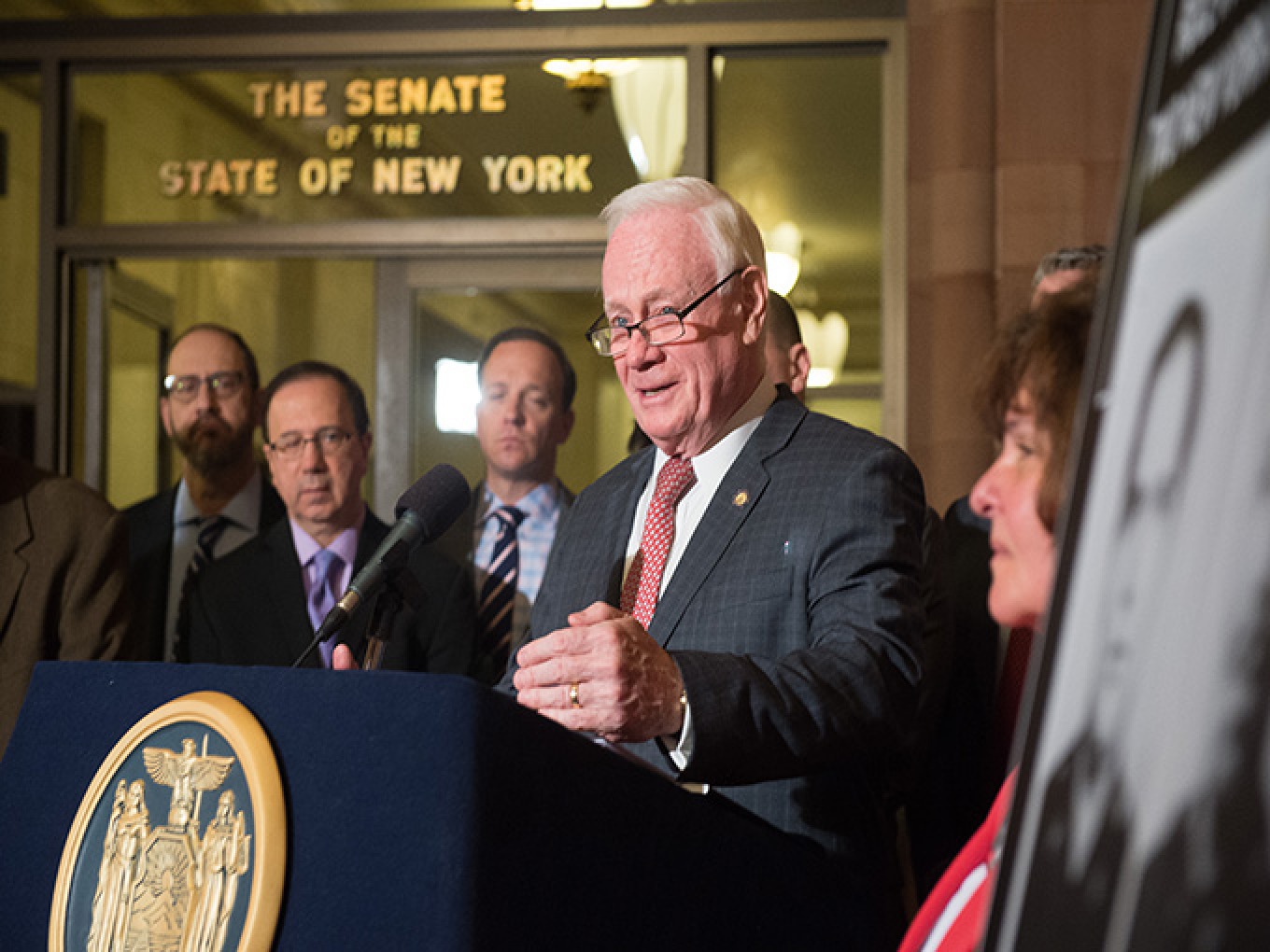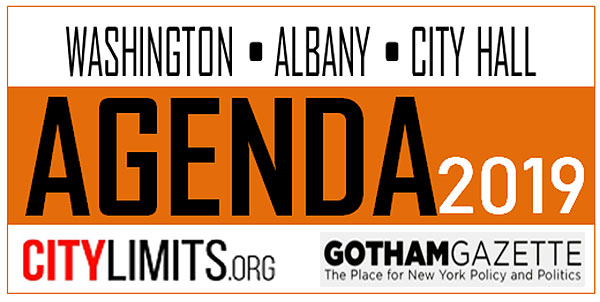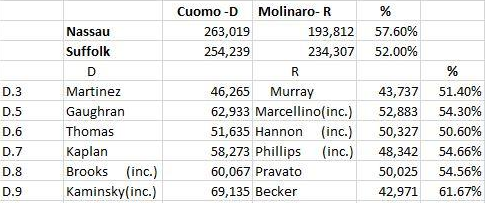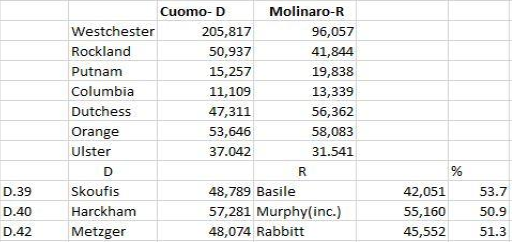Rebooting the Republican Party in New York City

Senator Marty Golden (photo via State Senate website)
The fall of State Senator Marty Golden and Congressional Rep. Dan Donovan should put the Brooklyn Republican Party on notice: there is a need for younger, more diverse candidates that can connect with the community, and provide unique solutions to problems plaguing our urban neighborhoods.
It’s no secret that New York City is a liberal bastion that has made it difficult for Republicans and the Republican Party to find an audience. However, that is just as much the fault of the local party apparatus as it is the tribalist politics of the five boroughs. The Brooklyn GOP has so far failed to reflect the people it’s trying to represent.
I agree with Republican Congressional Rep. Mia Love of Utah, recently defeated as she sought reelection, when she said, “Republicans never take minority communities into their home and citizens into their homes and into their hearts, they stay with Democrats and bureaucrats in Washington because they do take them home – or at least make them feel like they have a home.”
Today’s voters look to leaders who care about their needs. And to the vast majority of New York City voters, the Republican Party has become synonymous with callousness and corruption.
However, empathy and conservative principles are not mutually exclusive. If Republicans want to broaden our appeal among college-educated urban and suburban voters, we need to revisit George W. Bush’s compassionate conservatism.
We need to fight for people, not abstract concepts.
The next generation of Republicans must reaffirm a better future for all. We must get back to basics and start reconnecting with local communities – speak their language (even literally) – and, for example, explain what we would do to fight residential displacement.
New York City Republicans need to reach out to minority communities and refocus party priorities on bipartisan issues that the Mayor, the City Council, and Albany have consistently dropped the ball on, from housing to education, criminal justice to healthcare.
We need a message that sets us apart, that moves us beyond the demagoguery of Donald J. Trump and provides solutions to problems plaguing so many New Yorkers.
If that means adopting some liberal ideas, or compromising in order to codify a kinder, more gentler society then that is exactly what we should do – and we absolutely can do it without sacrificing our core principles of fiscal probity, free enterprise, personal freedom, individual responsibility, and self-government.
According to the New York State Board of Elections, there are 3.5 million registered Democrats and 522,540 registered Republicans in New York City.
Time to face reality.
The GOP has a lot to offer, but we need to figure out what we’re offering in an urban environment like New York and we need to be consistent here.
We have an obligation to stand up for everyday New Yorkers who are struggling to make it, who yearn to start a family, or are striving to raise one. If we’re about the working class then our statutes and our systems need to sing it from the rafters. We can’t get caught up in the quagmire of self-aggrandizement or appeasing special interests; it’s the overall community that matters, not party, and not corporate interests.
If we’re for rooting out corruption, then let’s root out corruption. No more corporate PAC money. No more labor union money. Only individuals.
And yes, we can have a great message, but messaging means nothing without the proper messengers.
Running young, qualified, well-vetted candidates that reflect local communities is our best way of communicating our ideas to a new audience. Communities outside of parts of Manhattan, brownstone Brooklyn, western Queens, and a few other places have been ignored and require more forceful, more vociferous representation at the state level.
Ultimately, it’s not about right versus left, Democrat versus Republican, but instead practical versus fantastical; smart versus irresponsible. There are major crises in state finances and with homelessness, public housing and public transportation; income inequality has sky-rocketed, and Democrats have few solutions other than spending more money. The status quo of corporate welfare is not working; New York’s business climate now consistently ranks 49 out of 50, according to the Tax Foundation.
We need to rethink how we’re doing almost everything in New York -- and Republicans can be the party of ideas and solutions.
This past election cycle has left many New York Republicans searching for answers. We can start to build a new Republican Party in New York City and State before it really is too late.
***
Joel Acevedo is a board member of the Brooklyn Young Republican Club and founder of the Sunset Park Republicans. On Twitter @JoelMAcevedo.
***
Have an op-ed idea or submission for Gotham Gazette? Email This email address is being protected from spambots. You need JavaScript enabled to view it.
A Simple First Step to Help the MTA Re-Establish Credibility

Andy Byford (photo: Marc A. Hermann / MTA New York City Transit)
This is part of AGENDA 2019, a joint Gotham Gazette-City Limits project
Find the rest of the series here
The Metropolitan Transportation Authority (MTA) is teetering on financial collapse and still struggling to overcome a meltdown in subway service and collapse in bus ridership. No one doubts that the MTA has serious problems and riders are suffering. But before the State Legislature approves tens of billions of new funding, the MTA needs to show it is serious about improving its decision-making and transparency.
Politically, the MTA has met the enemy: its lack of credibility.
Former Chair Joe Lhota at the MTA Board’s October 2018 meeting acknowledged this, saying, “I’m aware that before we can credibly appeal for billions of dollars of public money, we must continue to advance a reform agenda.” New York City Transit’s Fast Forward plan is a whopping $40 billion appeal and promise to improve the subways and buses. Andy Byford, New York City Transit’s president and the plan’s architect, in unveiling the plan stated that NYCT is working on the “rollout of a new transit organization - one that is built around a customer centric, continuous improvement model, one that emphasizes transparency and accountability, and one that going forward delivers on its promises.”
One of the easiest ways for the MTA to show that it is serious about improving transparency is to bring its Freedom of Information Law (FOIL) process into the 21st century. This means putting it fully online with an OpenFOIL website, modeled on the successful platforms already used by the Port Authority of New York and New Jersey and the City of New York, and as developed by the Obama administration for federal agencies.
The idea behind FOIL is that the public can ask for and get information that government decisions are based on -- information that we, the public, paid for with our taxes (and, in some cases, fares and tolls). Ideally, much of this information should already be online in an open format that is easy to search, download and use. But in 2018, the MTA is still a long way from putting important information online and in accessible formats. For journalists, researchers, and watchdogs that seek to hold the MTA accountable, that means FOIL is often the only way to get certain public records.
 Unfortunately, the way the MTA implements FOIL is not working for either MTA staff or the public. A recent report by my organization, FOIL that Works: Increasing MTA transparency and accountability by putting FOIL online, dug into the MTA’s FOIL process and found a dysfunctional and fragmented mess.
Unfortunately, the way the MTA implements FOIL is not working for either MTA staff or the public. A recent report by my organization, FOIL that Works: Increasing MTA transparency and accountability by putting FOIL online, dug into the MTA’s FOIL process and found a dysfunctional and fragmented mess.
The MTA received nearly 9,000 requests in 2017 (see chart below), with those inquiries handled differently among its eight separate agencies. New York City Transit still responds to many FOIL requests with paper letters instead of by email. Complicated requests can take over a year to fill, and most FOILers don’t have the legal resources to take the MTA to court to speed things up. FOIL requests might be deemed “closed” by agency staff, but this does not mean the requestor actually received the information sought.
There is a better way to do things, and fortunately for the MTA, it doesn’t have to look far. The Port Authority in 2012 revamped its freedom of information access policy, and created an online portal for FOI requests. This reform was led by Pat Foye, then the Port Authority executive director, and now the MTA’s president, as well as Scott Rechler, who has since switched boards to the MTA. Now, once a record is released to the public, it goes online in a searchable portal for everyone else to benefit from. This saves both the Port Authority staff and the public time - a win-win.

The City of New York also has an Open Records web portal, which eases the FOIL process for the public and agency staff. The code for the portal is available in open source, which is essentially free for the MTA to adopt and expand for its needs.
The MTA also doesn’t segregate information requests the way it should. As shown in the chart above, in 2017 two-thirds of MTA FOIL requests - more than 6,000 - were for police incident reports. But these don’t have to go through FOIL. The state Department of Motor Vehicles has an in-house online collision reports portal where the public can privately request their own incident reports, and the MTA should do the same. The MTA’s FOIL staff should focus on other types of FOIL requests to ensure that they don’t languish for so long.
OpenFOIL and an online police incidents portal for the MTA are supported by 13 other city, state, and national organizations - a diverse group including good government, transportation, freedom of information, and environmental organizations including the National Freedom of Information Coalition, Riders Alliance, League of Women Voters of the City of New York, NYPIRG Straphangers Campaign, and Environmental Advocates of New York.
The MTA can and should put FOIL online on its own. But should it not, the public has another important backstop - the state Legislature. Newly elected and re-elected legislators, in particular Senate Democrats, have promised to tackle MTA reform, and if the MTA can’t reform itself, they should require it. Passing legislation requiring OpenFOIL for the MTA is a great start for legislators to take their oversight role seriously.
This is part of AGENDA 2019, a joint Gotham Gazette-City Limits project
Find the rest of the series here
***
Rachael Fauss is Senior Policy Analyst at Reinvent Albany. On Twitter @RachaelFauss & @ReinventAlbany.
***
Have an op-ed idea or submission for Gotham Gazette? Email This email address is being protected from spambots. You need JavaScript enabled to view it.
New York Democrats Won Big on Election Night, But Many Legislative Wins Were Razor-Thin

rally for now Senator-elect Gounardes (photo: @LizKrueger)
The slumbering Democratic midterm electorate awakened this year, in New York and around the nation, and won significant victories. Across the country, the sum of the votes of the Democrats for every House of Representatives race in the nation is 60.1 million and counting. In 2014 only 35.6 million voted Democratic.
While Democrats are celebrating their booming turnout and major wins including flipping control of the House of Representatives, there’s a big question Democrats need to ponder: can they sustain and even grow this kind of voter turnout in 2020 and hold onto many razor-thin wins of these midterms? Will the Democrats stay motivated?
First, let’s look at some key numbers nationwide and in New York:
In 2018 the Democrats have gained more than 24 million more votes for the House Democratic candidates than in 2014 (this is called the National House Popular Vote), 67% more than the past midterm election. The Republican House Popular Vote this year is 50.7 million and counting, compared to 40.1 million in 2014, a gain of an extra 10.6 million, 26% over the prior midterm. The Democrats flipped 40 seats in the 435-seat House and took the majority, and there is still one race in California uncalled, according to the Cook Political Report.
In New York, Governor Cuomo and the statewide Democratic ticket won an overwhelming victory. Compare the election night results by region on New York's gubernatorial line in 2018 with those same regional results in 2014:

The overall statewide turnout increased more than 50%, from 3.8 million in 2014 to 5.7 million this year (absentee and other paper ballots will soon be added). In New York City, the turnout surged 90%, nearly doubling, from 1 million in 2014 to 1.9 million this year.
In the New York City suburbs, the turnout rose 46% over 2014, but, more importantly for the State Senate races, the Democratic turnout in the suburbs rose 60%, from 483,000 votes in 2014 to 774,000 votes in 2018. Governor Cuomo's margin in the suburbs in 2014 was 60,000, winning 52%-45%, but this year his margin rose to 208,000 votes, and a win of 57%-41%. The dramatic improvement in the suburbs for the Democrats was a critical factor in their flipping seven Republican State Senate seats, four on Long Island and three in the Hudson Valley (they won an 8th in Brooklyn).
Long Island Wins for Democrats
A look at the results on the Governor's line and the six seats won by Democrats, including two incumbents, on Long Island:

Republicans lost four State Senate seats on Long Island and have been wiped out in Nassau County. Just four years ago they held all nine Long Island seats; when the Democrats take control in January, the Republicans will hold three. Their troubles began with the corruption conviction of former Senate Majority Leader Dean Skelos; his seat was won by a Democratic Assembly member and former federal prosecutor, Todd Kaminsky, in a special election held the same day as the New York presidential primary in April 2016. Another Democrat, John Brooks, won a second Long Island Senate seat in November 2016 by 314 votes. This year Kaminsky won handily and Brooks won over 54%. In the four new victories the Democratic candidates had two 10,000-vote wins. The other two victories were close, however, one by 2,500 votes and the other by 1,400.
Hudson Valley Wins for Democrats
A look at the results on the Governor's line and the three Senate seats in the Hudson Valley where the Democrats won, by county in the northern suburbs of New York City and the upper Hudson Valley:

The Democrats won three Republican seats in the Hudson Valley. Democratic Assemblymember Jim Skoufis, who won his Assembly seat in 2012 at the age of 25, ran for the seat vacated by retiring Republican Bill Larkin and won by 6,700 votes, with nearly 54%. He won in Orange County by more than 4,000 votes and in Rockland County by 3,000 votes. Democrat Jen Metzger won the seat held by retiring Republican John Bonacic by a slim 2,500 votes, 51%-49%. She won Ulster County by 5,000 votes and lost Orange County by only 61 votes, 23,708 to 23, 647. Both Skoufis and Metzger likely ran ahead of Cuomo in Orange County, but his wins in Ulster and Rockland surely helped their campaigns.
Democrat Peter Harckham won the third seat in the Hudson Valley in another close race, defeating Republican incumbent Terence Murphy by 2,100 votes, 51%-49%. Harckham lost in both Putnam and Dutchess Counties, as did Cuomo, but he won solidly in Westchester, where most of the district is located, by 10,000 votes. Cuomo won Westchester County two-to-one. Democrats are celebrating their wins in the Hudson Valley, but two of the three wins were very tight.
Congressional Wins for Democrats
Below is a look at the results of the three Congressional wins in New York for the Democrats. The two upstate victories, in the 19th and 22nd Congressional districts, occurred entirely outside the New York City suburbs:

In the two upstate districts, the Democratic candidates ran ahead of Governor Cuomo, and needed to do so to win. In the 19th Congressional district, Democrat Antonio Delgado defeated incumbent Republican John Faso by over 7,500 votes. But in Ulster County he won by 16,000 votes, 43,000 to 27,000, while Cuomo's margin in Ulster was 6,000 (the Governor won there 37,000 to 31,000). Delgado also won by small margins in traditionally Republican Columbia and Dutchess County, while Cuomo lost there by slim margins. Faso defeated Delgado further north, in Rensselaer County and the Catskills, where Cuomo did not do well.
In Central New York, Democratic Assemblymember Anthony Brindisi overcame many challenges to win a very close race against incumbent Republican Claudia Tenney. Despite a 30,000 voter registration edge for the Republicans and polls showing majority approval of Trump in the district, Brindisi won by slightly more than 1%, 122,000 to 119.000. Nearly all the absentee ballots have been counted there. Brindisi won his home base in Oneida County 38,000 to 37,000, and won Broome County, where the City of Binghamton is located, by 8,000 votes. He managed to stay close to Tenney in other heavily Republican counties. Here's a comparison of the Cuomo-Molinaro race with the Brindisi-Tenney race in counties overlapping with the 22nd Congressional District. The results demonstrate how competitive Brindisi was in Republican turf.

New York City
In New York City the Democratic margins were staggering. Cuomo won 81%-15% and by 1.27 million votes. The lone New York City Republican member of Congress, Dan Donovan, was defeated. One of the only two Republican State Senators in New York City, Marty Golden, whose Brooklyn district somewhat overlapped Donovan's Congressional district, which is 70% Staten Island and 30% Brooklyn, was also defeated. Democrat Max Rose won the Brooklyn side of the Congressional district by 10,000 votes, and, amazingly, won Staten Island by 1,400 votes. The Democratic electorate on Staten Island woke up.
In the Democratic part of Staten Island, the North Shore, Rose won the Assembly district there by 16,000 votes, a margin Republicans were unable to overcome in the rest of Staten Island. Rose had more than double the vote of the Democratic candidate for the seat in 2014, 95,000 vs. 45,000. In the State Senate race, the Democratic candidate, Andrew Gounardes, defeated Senator Golden by just over 1,000 votes, another close election. Gournardes and Rose benefited from the energy and synergy of running in the somewhat overlapping sections of the Congressional and State Senate districts.
Keeping the Seats
2020 will be a big challenge for Democrats to hold the victories in New York and the nation. Many of the State Senate and Congressional wins were very close. Republicans in New York and the rest of the country will make intense efforts to recover during the presidential election, when turnout will be higher and President Trump will likely be on the ballot. Of course, Republicans have the repudiation of President Trump to blame for their losses this year. Exit polls also showed Democrats won the 18-29 age group by 35 points, a very encouraging long-term sign for Democrats. Nonetheless, the Republicans will be highly competitive in most, if not all, of these districts and the Democrats can take nothing for granted.
***
Jim Brennan was a member of the New York State Assembly for 32 years, where he chaired four committees. On Twitter @JimBrennanNY.
***
Have an op-ed idea or submission for Gotham Gazette? Email This email address is being protected from spambots. You need JavaScript enabled to view it.




